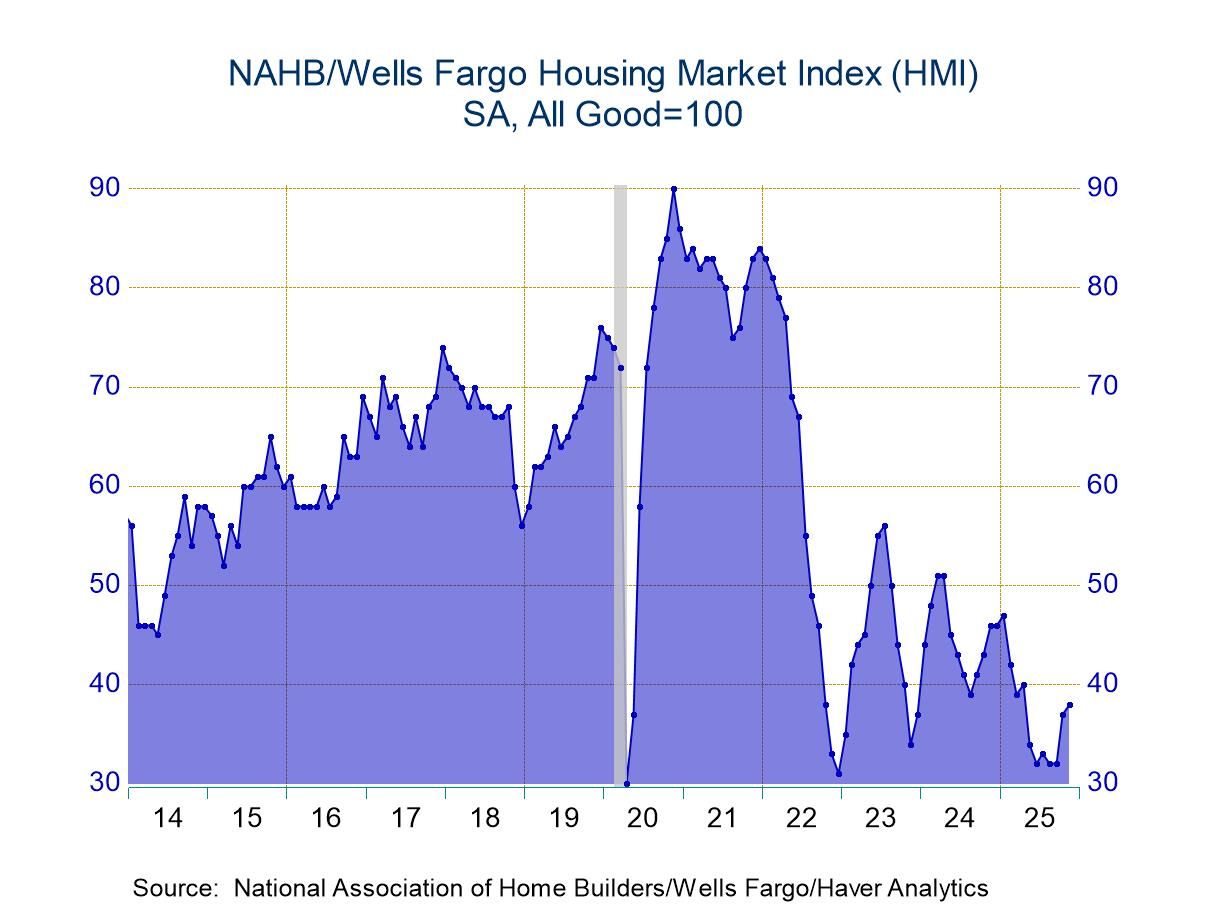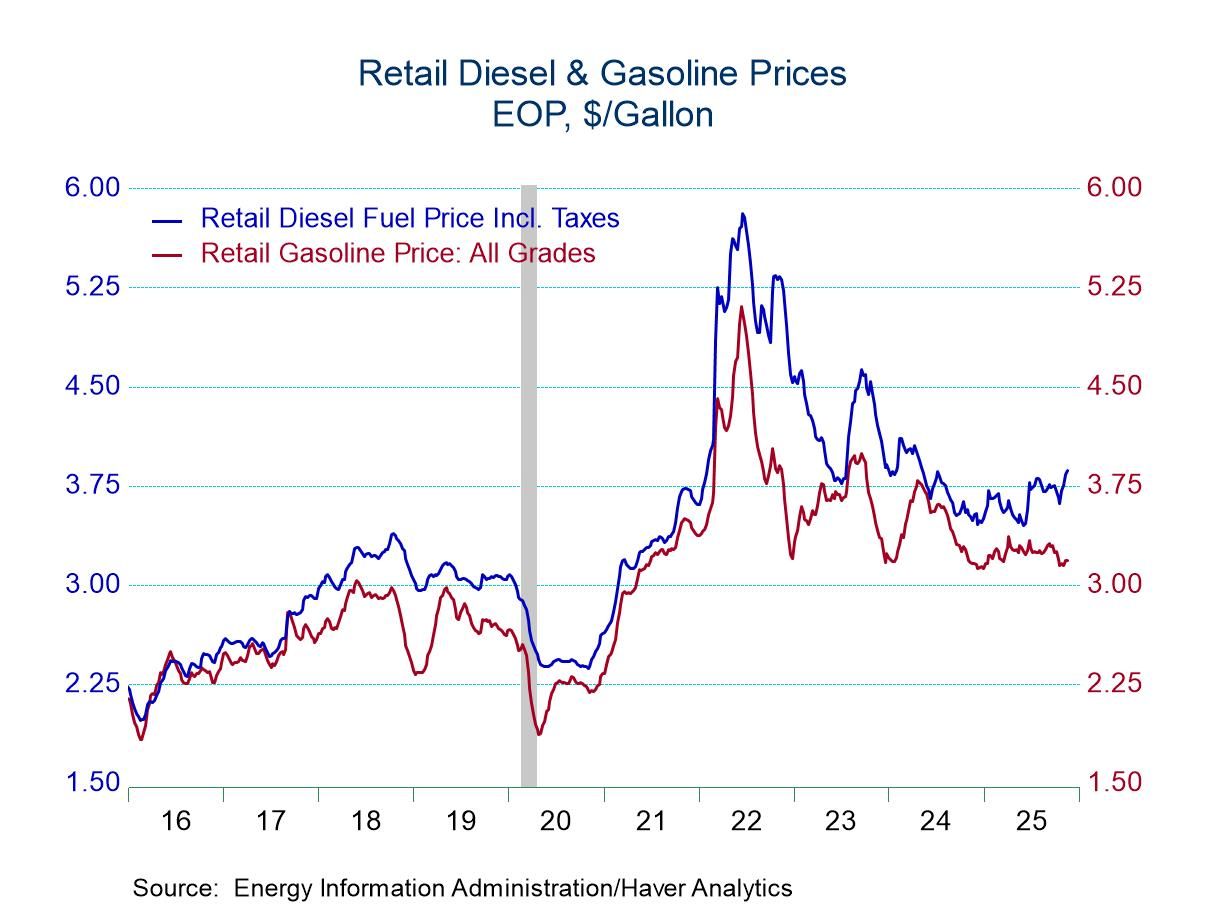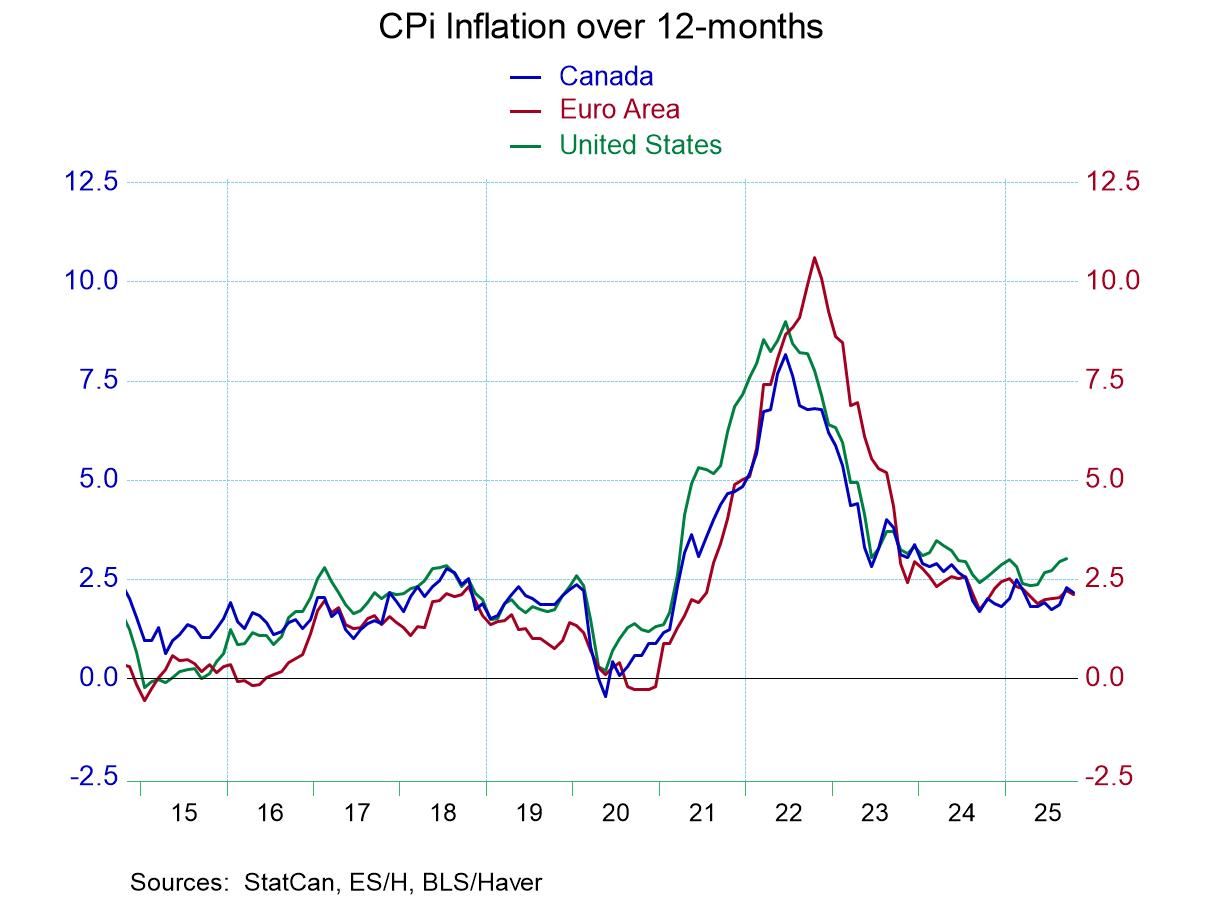 Global| Dec 15 2015
Global| Dec 15 2015U.S. CPI Remains Unchanged; Core Prices Increase Steadily
by:Tom Moeller
|in:Economy in Brief
Summary
The Consumer Price Index was unchanged (0.5% y/y) during November following a 0.2% October rise. Prices excluding food & energy increased 0.2% (2.0% y/y) for the third consecutive month. Both the total and core price figures matched [...]
The Consumer Price Index was unchanged (0.5% y/y) during November following a 0.2% October rise. Prices excluding food & energy increased 0.2% (2.0% y/y) for the third consecutive month. Both the total and core price figures matched expectations in the Action Economics Forecast Survey.
A 0.3% increase (2.9% y/y) in core services prices repeated the prior two months' gain. The increase in medical care prices eased to 0.4% (3.1% y/y). The rise was half the prior month's but the y/y increase of 3.1% was its swiftest since September 2013. Shelter prices rose 0.2% (3.2% y/y) after two months of 0.3% increase as owners equivalent rent of primary residences increased a steady 0.2%. The 3.1% y/y increase compared to little change in 2010. Rents of primary residences gained just 0.2%, but here again the y/y rise was a strong 3.6%. Public transportation services prices increased 0.5% (-1.8% y/y) and recreation services costs remained unchanged; the 2.4% y/y rise was double that of a year ago.
Energy prices declined 1.3% (-14.7% y/y) led by a 2.4% drop (-24.1% y/y) in gasoline prices. Natural gas costs were off 1.9% (-11.7% y/y) and fuel oil prices fell 1.3% (NSA), down roughly one-third y/y. Electricity costs increased 0.3% (-0.2% y/y).
Goods prices excluding food & energy eased 0.2% (-0.6% y/y), off for the sixth month in the last seven. Appliance prices fell 1.3% (-4.2% y/y), also down for the sixth month in the last seven. Home furnishings costs were off 0.5% NSA (-1.4% y/y). Recreation goods prices declined 0.6% (-2.6% y/y) and apparel costs fell 0.3% (-1.5% y/y). Offsetting these declines, new vehicle prices ticked up 0.1% (0.2% y/y) and medical care commodity prices gained 0.3% (2.5% y/y), the strongest change in three months. Education books and supplies prices jumped 0.6% (4.6% y/y).
Food prices eased 0.1% (1.3% y/y), falling for the first time since April. Egg prices declined 3.8% (+23.7% y/y), down for the third straight month. Meat prices were off 0.6% (-2.1% y/y) and cereal prices fell 1.2% (+0.1% y/y), reversing the prior month's increase. Nonalcoholic beverage prices declined 0.5% and were unchanged y/y. To the upside for the fifth straight month were fruit & vegetable prices, up 0.6% (1.4% y/y).
The consumer price data is available in Haver's USECON database while detailed figures can be found in CPIDATA. The expectations figure is from Action Economics and is found in the AS1REPNA database.
Why Ask? The Role of Asking Prices in Transactions from the Federal Reserve Bank of Philadelphia is available here
| Consumer Price Index, All Urban Consumers (%) | Nov | Oct | Sep | Nov Y/Y | 2014 | 2013 | 2012 |
|---|---|---|---|---|---|---|---|
| Total | 0.0 | 0.2 | -0.2 | 0.5 | 1.6 | 1.5 | 2.1 |
| Total less Food & Energy | 0.2 | 0.2 | 0.2 | 2.0 | 1.7 | 1.8 | 2.1 |
| Goods less Food & Energy | -0.2 | -0.1 | 0.0 | -0.6 | -0.3 | -0.0 | 1.3 |
| Services less Energy | 0.3 | 0.3 | 0.3 | 2.9 | 2.5 | 2.4 | 2.4 |
| Food | -0.1 | 0.1 | 0.4 | 1.3 | 2.4 | 1.4 | 2.6 |
| Energy | -1.3 | 0.3 | -4.7 | -14.7 | -0.3 | -0.7 | 0.9 |
Empire State Factory Sector Activity Remains Negative
by Tom Moeller December 15, 2015
The Empire State Factory Index of General Business Conditions remained negative for the fourth consecutive month during November. The reading of -10.74 compared to an unrevised -11.36 in October. These diffusion indexes were nearly the lowest since April 2009. The latest figure disappointed expectations for -6.0 in the Action Economics Forecast Survey. The data are reported by the Federal Reserve of New York and reflect business conditions in New York, northern New Jersey and southern Connecticut.
Based on these figures, Haver Analytics calculates a seasonally adjusted index that is compatible to the ISM series. The adjusted figure improved slightly to 47.0, but also was near the six-year low. A rising level of activity is indicated by a figure above 50. Since inception in 2001, the business conditions index has had a 62% correlation with the change in real GDP.
The component series showed mixed results this month. The employment figure remained in negative territory for the third month, near its lowest point since December 2012. During the last ten years, there has been a 72% correlation between the employment series and the m/m change in factory sector payrolls. New orders neared the lowest level since 2009. Shipments improved but still were at a three-month low. Vendor delivery speeds remained at the fastest pace since December 2014 and unfilled orders declined.
The prices paid index improved slightly to the highest point in three months. A sharply reduced 11% of respondents reported higher prices but a sharply reduced 6% reported them lower. Prices received remained in negative territory.
Expectations for business conditions fell sharply to the lowest level since November 2012. New orders and shipments deteriorated sharply but unfilled orders and inventories surged. Employment also gained to the highest level in six months but prices paid remained weak.
The Empire State figures are diffusion indexes which are calculated by subtracting the percent of respondents reporting poorer business conditions from those reporting improvement. Thus, they have a good correlation with growth in the series covered. The data is available in Haver's SURVEYS database. The ISM-adjusted headline index is calculated by Haver Analytics. The series dates back to 2001. The Action Economics figure can be found in Haver's AS1REPNA database.
| Empire State Manufacturing Survey | Dec | Nov | Oct | Dec'14 | 2014 | 2013 | 2012 |
|---|---|---|---|---|---|---|---|
| General Business Conditions Index (ISM Adjusted, >50=Increasing Activity, SA) | 47.0 | 46.3 | 53.8 | 53.4 | 50.7 | 51.9 | |
| General Business Conditions (Diffusion Index, %, SA) | -10.74 | -11.36 | 10.33 | 11.83 | 3.87 | 4.22 | |
| New Orders | -11.82 | -18.91 | 9.12 | 7.89 | 1.16 | 1.46 | |
| Shipments | -4.10 | -13.61 | 10.61 | 12.09 | 4.52 | 11.20 | |
| Unfilled Orders | -18.18 | -15.09 | -7.45 | -9.03 | -8.74 | -8.83 | |
| Delivery Time | -10.91 | -11.32 | -9.57 | -5.43 | -3.52 | -0.30 | |
| Inventories | -17.27 | -7.55 | 0.00 | -1.80 | -5.73 | -2.91 | |
| Number of Employees | -7.27 | -8.49 | 8.51 | 10.85 | 3.73 | 8.62 | |
| Prices Paid | 4.55 | 0.94 | 10.64 | 20.90 | 21.53 | 24.71 |
U.S. Home Builders Index Falls Again The Composite Housing Market Index from the National Association of Home
Builders-Wells Fargo declined 1.6% to 61 during December after falling 4.6% in
November. It was the lowest level in three months and the figure fell short of
expectations for 63 in the Informa Global Markets Survey. The NAHB figures are
seasonally adjusted. During the last ten years, there has been an 80%
correlation between the y/y change in the home builders index and the y/y change
in single-family housing starts. The index of single-family home sales fell 1.5% (+6.5% y/y) to 66. Similarly,
the index of expected sales during the next six months declined 2.9% (+4.7% y/y)
to 67. Home builders reported that their traffic index fell 4.2% to 46, the lowest
level since August. The housing market index decline reflected declines through most of the
country. In the Midwest, the homebuilders index declined 8.3% (+1.9% y/y) to the
lowest level since May and for the Northeast it eased 2.0% (+6.5% y/y). In the
West, the index fell 1.3% (+2.7% y/y) and reversed the November gain but in the
South it remained unchanged (6.9% y/y). The NAHB has compiled the Housing Market Index since 1985. It reflects
survey questions asking builders to rate market conditions as "good,"
"fair," "poor" or "very high" to "very
low." The figure is thus a diffusion index with numerical results over 50
indicating a predominance of "good" readings. The weights assigned to
the individual index components are .5920 for single-family detached sales,
present time, .1358 for single-family detached sales, next six months and .2722
for traffic of prospective buyers. The results are included in Haver's SURVEYS
database. The expectations figure is available in Haver's MMSAMER database.
by Tom Moeller December
15, 2015
National Association of Home
Builders
Dec
Nov
Oct
Dec'14
2015
2014
2013
Composite Housing Market Index, SA (All
Good=100)
61
62
65
58
59
52
51
Single-Family Sales: Present
66
67
70
62
64
56
55
Single-Family Sales: Next Six
Months
67
69
75
64
66
61
58
Traffic of Prospective Buyers
46
48
47
46
43
39
39
U.S. Crude Oil Prices Touch Seven-Year Low; Gasoline Prices Ease
by Tom Moeller December 15, 2015
WTI crude oil costs declined to $40.40 (-39.9% y/y) last week, and yesterday dropped to a seven-year low of $37.65 per barrel. Brent crude oil prices fell w/w to $42.41 per barrel last week and were $40.65 yesterday. WTI prices reached $107.23 in June 2014.
Gasoline prices at the pump declined last week to $2.05 per gallon, down one penny from the prior week. Prices were down 23.4% y/y and roughly equaled the January low of $2.04. Haver Analytics constructs factors adjusting for the seasonal variation in pump prices. The seasonally adjusted price declined to $2.20 per gallon. Moving sharply lower was the spot market gasoline price. It fell to $1.34 per gallon (-29.8% y/y).
Natural gas prices improved last week to $2.12 per mmbtu (-41.8% y/y) and were $2.03 yesterday.
Price declines occurred as the supply of petroleum products continued to outpace demand. Gasoline inventories increased 4.0% y/y and inventories of all petroleum products rose 10.4% y/y. Crude oil production (input to refineries) increased 1.5% y/y during the last four weeks. Gasoline demand eased 0.6% y/y last week and demand for all petroleum products declined 1.6% y/y.
The energy price data are reported by the U.S. Department of Energy. The petroleum demand and inventory figures are from the Oil & Gas Journal Weekly. These data can be found in Haver's WEEKLY database. The daily figures are in DAILY and greater detail on prices, demand and production, along with regional breakdowns, are in OILWKLY.
| Weekly Energy Prices | 12/14/15 | 12/07/15 | 11/30/15 | Y/Y% | 2014 | 2013 | 2012 |
|---|---|---|---|---|---|---|---|
| Retail Gasoline ($ per Gallon, Regular) | 2.05 | 2.06 | -23.4 | 2.30 | 3.33 | 3.30 | |
| Light Sweet Crude Oil, WTI ($ per bbl., WSJ) | 40.40 | 40.49 | -39.9 | 93.64 | 97.96 | 94.20 | |
| Natural Gas ($/mmbtu, LA, WSJ) | 2.12 | 2.10 | -41.9 | 4.37 | 3.73 | 2.75 |
Tom Moeller
AuthorMore in Author Profile »Prior to joining Haver Analytics in 2000, Mr. Moeller worked as the Economist at Chancellor Capital Management from 1985 to 1999. There, he developed comprehensive economic forecasts and interpreted economic data for equity and fixed income portfolio managers. Also at Chancellor, Mr. Moeller worked as an equity analyst and was responsible for researching and rating companies in the economically sensitive automobile and housing industries for investment in Chancellor’s equity portfolio. Prior to joining Chancellor, Mr. Moeller was an Economist at Citibank from 1979 to 1984. He also analyzed pricing behavior in the metals industry for the Council on Wage and Price Stability in Washington, D.C. In 1999, Mr. Moeller received the award for most accurate forecast from the Forecasters' Club of New York. From 1990 to 1992 he was President of the New York Association for Business Economists. Mr. Moeller earned an M.B.A. in Finance from Fordham University, where he graduated in 1987. He holds a Bachelor of Arts in Economics from George Washington University.






